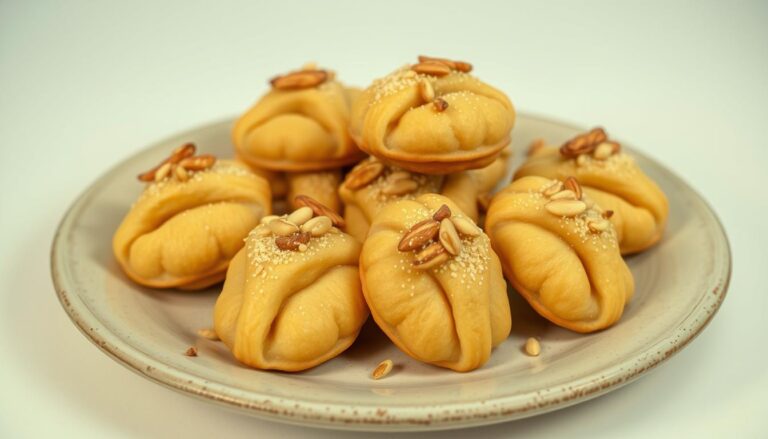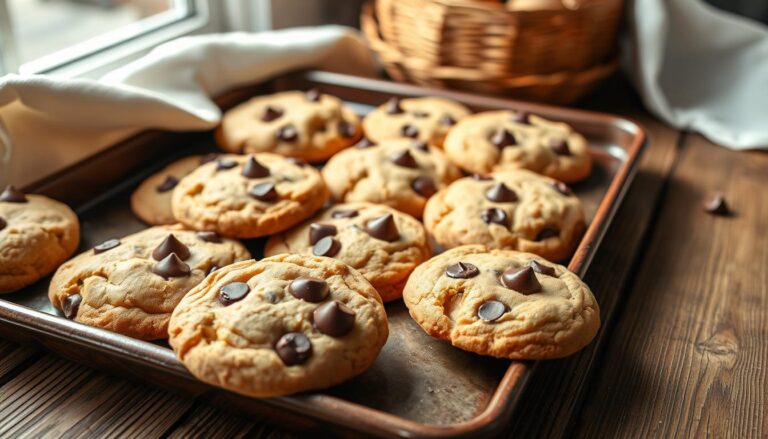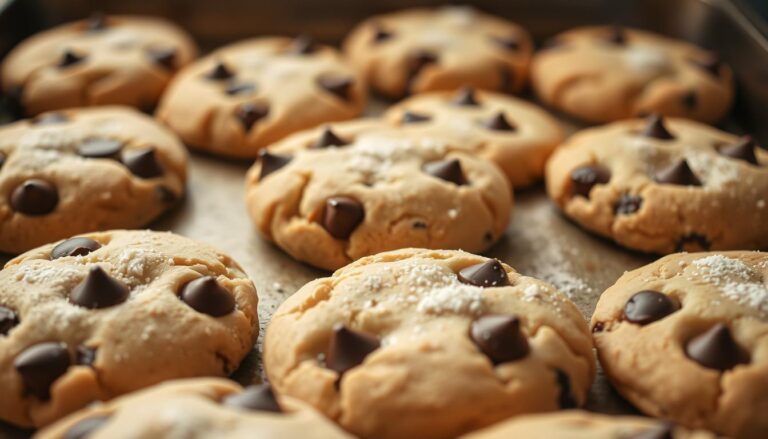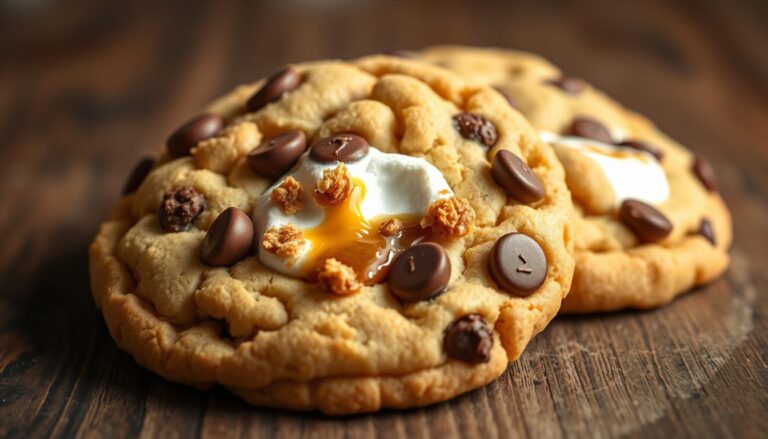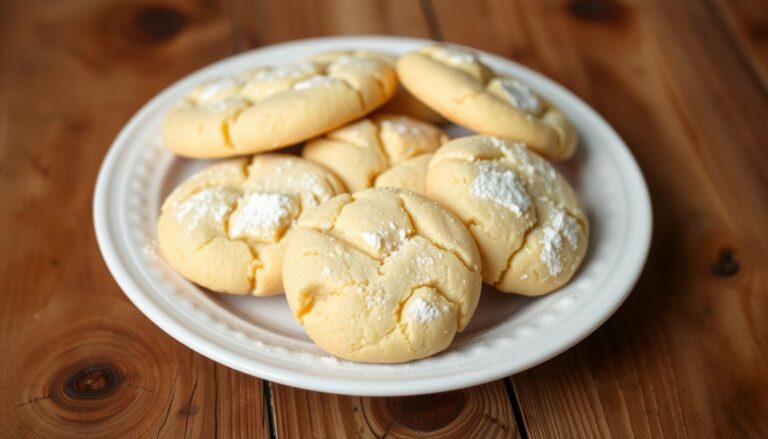Madeleine Cookies: Irresistible French Delight
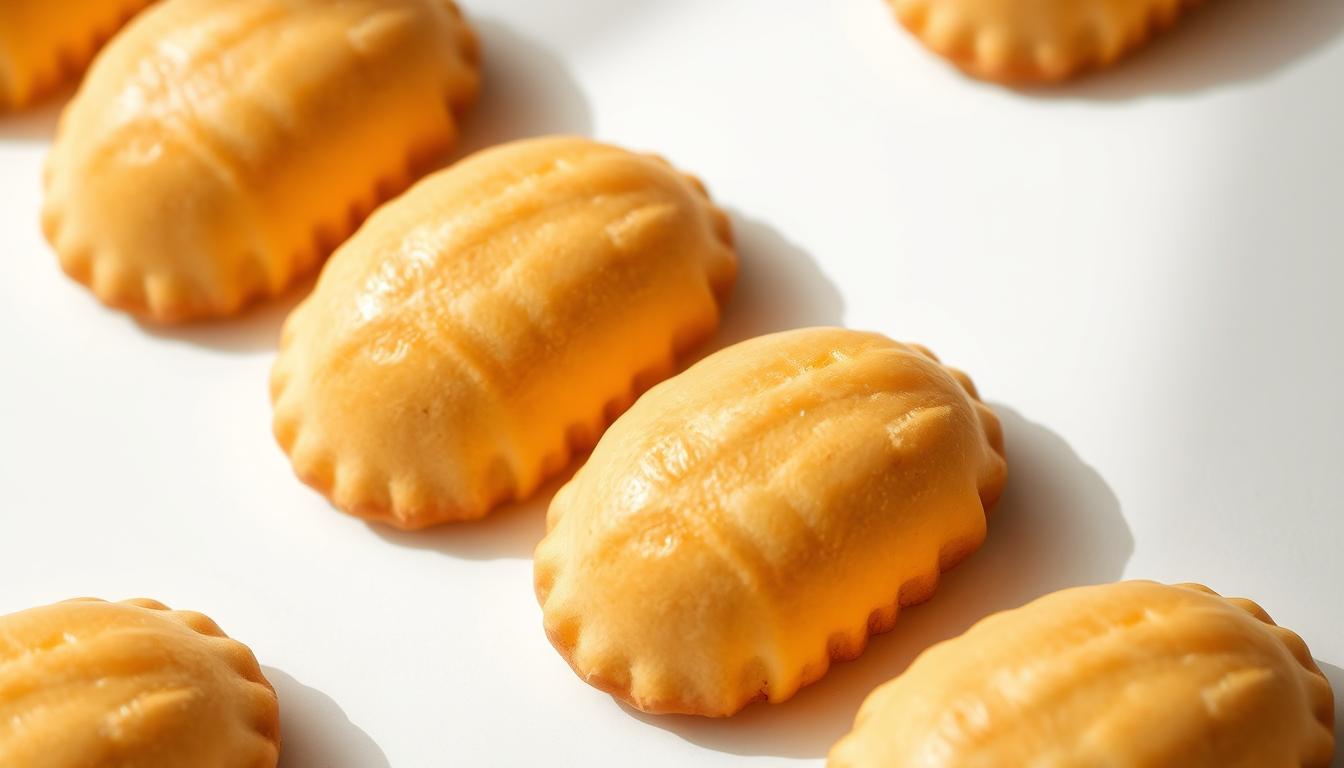
The first time I tasted a madeleine cookie, it was magical. It felt like stepping into a French bakery on a sunny day. The cookies’ shape and golden edges told stories of tradition and skill.
Madeleine cookies are more than a sweet treat. They are a journey through taste and time. Soft, buttery, and beautifully shaped, they have won hearts around the world. Their unique texture and rich history make them special.
If you love baking or just enjoy great pastries, madeleine cookies are for you. They take you on a journey through French baking. Get ready to discover the charm of these iconic treats that are both cookies and cakes.
Table of Contents
Key Takeaways
- Madeleine cookies are a classic French delicacy with a distinctive shell shape
- They bridge the culinary gap between cookies and small cakes
- These treats offer a rich sensory experience rooted in French baking tradition
- Madeleines are known for their delicate, buttery texture
- They represent more than just a sweet – they’re a cultural culinary symbol
Understanding the Classic French Madeleine
When you first try traditional madeleine cookies, you’ll feel like you’re in France. These delicate treats are more than just a snack. They’re a deep dive into French culture that has won hearts for ages.
A Journey Through Culinary History
The tale of famous madeleine cookies starts in France’s Lorraine region. These shell-shaped treats have a rich history that mixes myth and skill. It’s said they were named after Madeleine, a young baker who made them for a French noble.
“A madeleine is not just a cookie, it’s a piece of French cultural heritage you can taste.” – French Pastry Chef
What Sets Madeleines Apart
Traditional madeleine cookies are special for several reasons:
- Distinctive shell-like shape
- Soft, sponge-like texture
- Delicate buttery flavor
- Signature golden-brown hump
Cake or Cookie? The Delicious Debate
Madeleines start a fun debate about what they are. They’re between a cake and a cookie in texture. Their light inside and crisp edges make them a special treat.
Whether you call them a cookie or a small cake, one thing is clear. Famous madeleine cookies are a favorite French treat that wins hearts around the world.
Essential Ingredients for Perfect Madeleine Cookies
Creating the best madeleine cookie recipe starts with choosing top-notch ingredients. Each ingredient is key to making these French treats that are soft and delicious.
For your homemade madeleine cookies, you’ll need a few high-quality ingredients. These ingredients turn simple baking into a work of art. The main ingredients for your madeleine masterpiece are:
- Eggs: Fresh, room-temperature eggs create the signature light texture
- Sugar: Fine granulated sugar provides the perfect sweetness
- All-purpose flour: Ensures a delicate, tender crumb
- Unsalted butter: Adds richness and depth of flavor
- Vanilla extract: Brings warm, aromatic notes
- Lemon zest: Offers a bright, citrusy undertone
Choosing the right ingredients is crucial for authentic madeleines. Use organic eggs, pure vanilla extract, and fresh citrus for zesting. Your effort in picking the best ingredients will make your homemade madeleine cookies truly special.
“The secret to perfect madeleines lies in the quality of your ingredients and the precision of your technique.” – French Pastry Chef
Pro tip: Always measure ingredients precisely and bring them to room temperature before mixing. This attention to detail makes all the difference between a good baker and a great one.
Tools and Equipment for Baking Madeleines
To bake madeleine cookies, you need specific tools and equipment. These help you make the perfect French treat. Choosing the right tools can greatly improve your baking experience and the taste of your cookies.
Starting to bake madeleine cookies means having the right tools. Professional bakers know that special tools make a big difference. They take your baking from good to great.
Choosing the Right Madeleine Pan
The key tool for baking madeleine cookies is the shell-shaped pan. Look for these important features when picking your pan:
- Non-stick metal construction
- Precise shell-shaped indentations
- Heavy-gauge material for even heat distribution
- Available in aluminum or steel
Other Essential Baking Tools
You’ll also need some extra tools to make perfect cookies:
- Electric mixer or whisk
- Pastry brush
- Sifter for dry ingredients
- Cooling rack
- Offset spatula
Pan Preparation Techniques
Preparing your pan is key for baking madeleine cookies. Carefully grease each shell-shaped cavity with butter and dust with flour. This ensures your cookies come out easily after baking. Some bakers use baking spray with flour for an easier prep.
Invest in quality tools, and you’ll be ready to make authentic, delicious madeleines. These will capture the true essence of French pastry baking.
The Art of Brown Butter in Madeleine Making
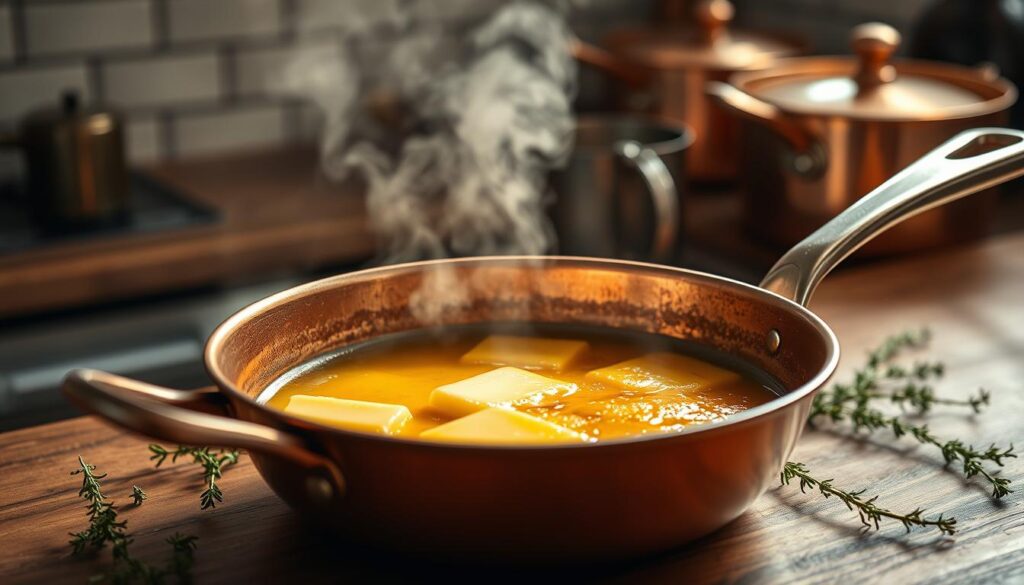
Starting with brown butter is key to making your madeleine cookies special. This method turns regular butter into a flavor bomb. It gives French madeleine cookies their unique nutty taste.
Brown butter, or beurre noisette, is more than a cooking trick. It’s a magic that adds depth and complexity to your baking. By heating butter slowly, its milk solids caramelize. This creates a rich, toasted flavor that makes your madeleine cookies taste even better.
- Heat butter in a light-colored pan for better visibility
- Stir consistently to prevent burning
- Watch for golden brown color and nutty aroma
- Remove from heat immediately to stop caramelization
The science behind brown butter is really cool. As butter heats up, water evaporates and milk solids start to brown. This releases complex flavors that standard melted butter can’t match.
| Butter Stage | Color | Flavor Profile |
|---|---|---|
| Melted | Yellow | Neutral |
| Brown Butter | Golden Brown | Nutty, Caramelized |
Using brown butter in French madeleine cookies adds a gourmet twist. It takes these cookies from good to amazing. Your baked treats will have a sophisticated taste that will impress anyone.
Step-by-Step Guide to Making Madeleine Cookies
Making madeleine cookies is an art that needs precision and patience. These French treats may look hard, but with the right steps, you can make them at home.
To master making madeleine cookies, you must learn key techniques. These steps turn simple ingredients into beautiful pastries. You’ll need to prepare carefully, chill, and bake to get the right texture and shape.
Preparing the Batter
Creating the perfect madeleine batter is all about detail. Start by:
- Whisking eggs and sugar until light and fluffy
- Gently folding in flour to keep air bubbles
- Adding melted butter for a rich flavor
Chilling Process
The chilling step is key for real madeleines. Refrigerate your batter for at least 2-4 hours. This lets flavors meld and texture set, giving you that classic hump and crumb.
Baking Techniques
Baking madeleines needs exact temperature and technique. Preheat your oven to 375°F. Follow these steps:
- Grease your madeleine pan well
- Fill molds about 3/4 full
- Bake for 10-12 minutes until edges are golden
With practice, you’ll get the hang of making madeleine cookies. They’ll be light, buttery, and irresistible.
Common Mistakes to Avoid When Baking Madeleines

Baking madeleine cookies can be tricky, even for experienced bakers. Knowing common mistakes helps you make perfect, delicate treats every time. The secret to great madeleine cookies is mastering a few key techniques.
One big challenge is managing your batter. Overmixing can ruin the delicate texture you want. When mixing ingredients, use a gentle folding method. This prevents overdeveloping gluten, which makes cookies dense and tough.
- Mix ingredients until just combined
- Use room temperature eggs
- Ensure butter is properly melted and cooled
- Sift dry ingredients to prevent lumps
Temperature control is key when baking madeleine cookies. Preheat your oven to 400°F (200°C) before adding the batter. Start with a high temperature to create the signature hump, then lower to 375°F (190°C) to finish baking. This method gives you a golden-brown outside and a tender inside.
Using high-quality ingredients is crucial for success. Always choose fresh, unsalted butter and check flour expiration dates. Refrigerating the batter for at least one hour helps flour hydrate and improves flavor. This makes your madeleine cookies even more delicious.
Pro tip: Gentle mixing and proper resting are the secrets to perfect madeleine cookies!
Classic Flavor Variations and Add-ins
Delicious madeleine cookies open up a world of creativity. They go beyond their traditional recipe. Whether you love baking or desserts, trying new flavors can turn these French treats into exciting adventures.
Traditional madeleine cookies have simple yet elegant flavors. These flavors show off the delicate nature of these shell-shaped treats. Let’s explore some exciting flavor options to make your baking more fun.
Classic Flavor Foundations
- Vanilla: The most traditional and pure madeleine flavor
- Lemon: A bright, citrusy twist that adds freshness
- Almond: Nutty and sophisticated flavor profile
Modern Flavor Innovations
Today’s bakers are trying new things with madeleine cookies. They mix unexpected ingredients and bold flavors.
- Chocolate: Rich and decadent dark or milk chocolate variations
- Lavender: Subtle floral notes for an elegant touch
- Matcha: Japanese-inspired green tea flavor
- Spiced varieties like cinnamon or cardamom
Glazing and Coating Options
Make your madeleine cookies look and taste even better with creative glazes and coatings. They add visual appeal and extra flavor.
- Dark chocolate dip
- Citrus-infused glaze
- Toasted nut sprinkles
- Powdered sugar dusting
The secret to amazing madeleines is mixing tradition with creativity. Don’t be shy to try new things and find your own special flavor mix!
Storage and Serving Suggestions
Your freshly baked homemade madeleine cookies need special care. They are best enjoyed within a few hours of baking. But, with the right steps, you can keep their taste and texture great for longer.
To keep your homemade madeleine cookies fresh, follow these steps:
- Store in an airtight container at room temperature
- Consume within 2 days for optimal freshness
- Separate layers with parchment paper to prevent sticking
- Avoid refrigerating, as this can dry out the delicate texture
Here are some ways to make serving your madeleines special:
- Dust with powdered sugar before serving
- Pair with a hot espresso or afternoon tea
- Serve on a decorative plate for a touch of French elegance
- Offer as a light dessert after a meal
If your homemade madeleine cookies get a bit stale, there’s a fix. Just warm them up in the oven at 300°F for 2-3 minutes. This trick will make them feel almost as fresh as when they first came out.
Pro tip: Always let your madeleines cool completely before storing to prevent moisture buildup.
Tips for Achieving the Perfect Madeleine Hump
Making the iconic hump is key to a real madeleine. It shows you’re serious about baking. Getting the hump right needs precision and a grasp of baking science.
Temperature is crucial for the hump. When baking, focus on two temperature moments:
- Refrigerate the batter for at least 1 hour before baking
- Preheat your madeleine pan in the oven
- Start baking at a high initial temperature
The trick is thermal shock. Cold batter in a hot pan causes quick rising and the hump. Bakers suggest a temperature drop from 375°F to 350°F during baking.
Your batter’s texture is also vital. It should be light and airy, thanks to well-beaten eggs and butter. Fold ingredients gently to keep air bubbles, which help form the hump.
Pro tip: Overmixing destroys the delicate structure needed for the perfect madeleine hump.
For the best results, keep practicing and be patient. Each batch will help you master the art of the classic French pastry bump.
Conclusion
Exploring classic madeleine cookies takes you on a journey through French baking traditions. These delicate cookies are more than treats; they are a part of a rich heritage. They delight both home bakers and professional chefs.
Now, you know how to make these elegant cookies with ease. You’ve learned about the importance of brown butter and how to create the signature hump. This knowledge lets you turn simple ingredients into a sophisticated dessert that wows everyone.
Classic madeleine cookies offer endless possibilities for creativity. You can stick to traditional flavors or try new ones. These cookies add a touch of Parisian elegance to your cooking, making them a great addition to your baking.
Start your madeleine baking journey and show off your skills. With practice and patience, you’ll make these delicious treats that showcase French pastry craftsmanship.
FAQ
What exactly are madeleine cookies?
Are madeleines difficult to make at home?
What makes the classic madeleine hump so special?
Can I make variations of traditional madeleine cookies?
How long do homemade madeleines stay fresh?
Do I really need a special madeleine pan?
What is brown butter, and why is it important in madeleine recipes?
Are madeleines considered a cookie or a cake?
Leave a review :
There are no reviews yet. Be the first one to write one.


